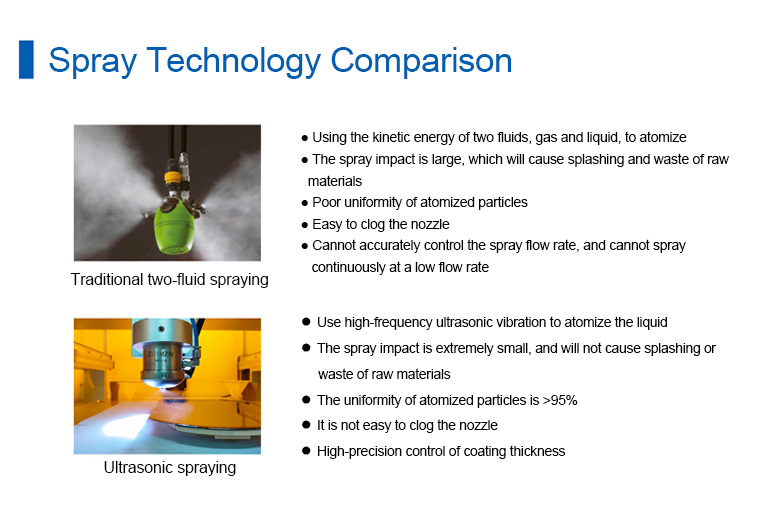google-site-verification: google0228a1feb97d321e.html
google-site-verification: google0228a1feb97d321e.html
google-site-verification: google0228a1feb97d321e.html
google-site-verification: google0228a1feb97d321e.html
google-site-verification: google0228a1feb97d321e.html
google-site-verification: google0228a1feb97d321e.html
Preparation of membrane electrode coating——Ultrasonic spraying
Compared with traditional spray gun technology, ultrasonic spray technology has obvious differences in material utilization, loss and advantages:
Material utilization and loss
Ultrasonic spray technology: The raw material utilization rate of ultrasonic spray is more than 4 times that of ordinary air spray, and the utilization rate can reach more than 90%. Because it uses ultrasonic oscillation to atomize liquid, the atomization process does not require pressure, and only a very low carrier gas pressure is applied after atomization to transport liquid mist, which greatly reduces the liquid rebound and splashing caused by high-pressure air in two-fluid spraying, thereby reducing material loss.
Traditional spray gun technology: The material utilization rate of traditional air spray guns is usually low, generally around 30%-45%. Traditional spray guns rely on the pressure of compressed air to complete atomization. High atomization pressure will cause the atomized paint to have a larger flow rate, and it is easy to rebound and form overspray when sprayed on the surface of the workpiece, resulting in a large amount of paint waste.

Advantages of ultrasonic spraying catalysts to improve utilization:
1. Improve catalytic performance
● Highly uniform coating: It can produce extremely high coating uniformity, making the catalyst more evenly distributed on the surface of the substrate, avoiding the situation where the local catalyst concentration is too high or too low, thereby improving the catalytic activity, and then improving the overall performance of the device using the catalyst, such as improving the power generation efficiency of the battery in a fuel cell.
● Accurate thickness control: By adjusting the spraying parameters, such as spraying time, liquid flow rate, ultrasonic frequency, etc., the thickness of the catalyst coating can be accurately controlled to meet the specific requirements of the catalyst dosage in different application scenarios, ensure the efficient use of the catalyst, and avoid the reduction of catalytic efficiency or material waste caused by too thick or too thin coating.
2. Enhance material compatibility
● Adapt to a variety of coatings: Ultrasonic spraying can be applied to a variety of liquid catalyst coatings, especially in the catalyst preparation process, it can easily introduce different materials and additives to achieve the preparation of multifunctional coatings, and can flexibly adjust the composition of the catalyst solution according to the specific catalytic reaction requirements to improve the adaptability and pertinence of the catalyst, thereby improving its utilization rate.
3. Reduce production costs
● Reduce the amount of expensive materials: Due to the improvement of material utilization and catalytic performance, the amount of expensive catalysts used can be reduced while achieving the same catalytic effect, thereby reducing production costs. For example, in fuel cells, for precious metal catalysts such as platinum, ultrasonic spraying technology can greatly improve their utilization rate and reduce the amount of platinum.
